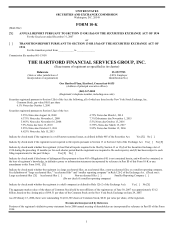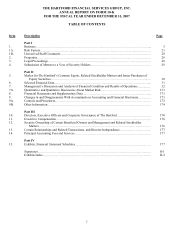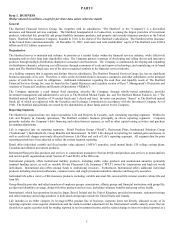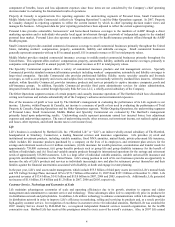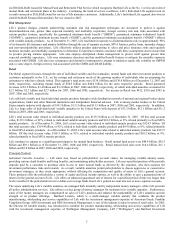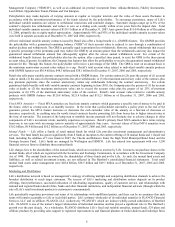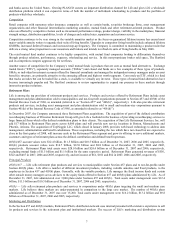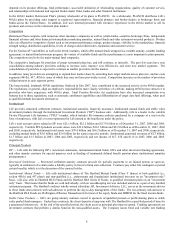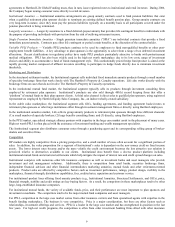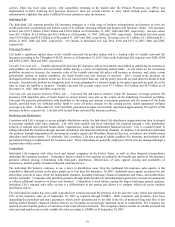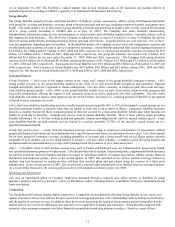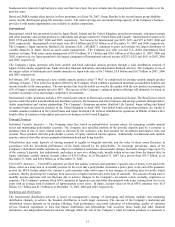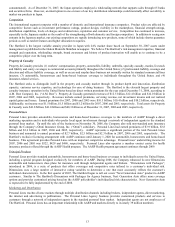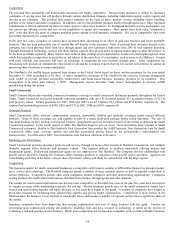The Hartford 2007 Annual Report Download - page 4
Download and view the complete annual report
Please find page 4 of the 2007 The Hartford annual report below. You can navigate through the pages in the report by either clicking on the pages listed below, or by using the keyword search tool below to find specific information within the annual report.4
component of benefits, losses and loss adjustment expenses since these items are not considered by the Company’ s chief operating
decision maker in evaluating the International results of operations.
Property & Casualty is organized into five reporting segments: the underwriting segments of Personal Lines, Small Commercial,
Middle Market and Specialty Commercial (collectively “Ongoing Operations”); and the Other Operations segment. In 2007, Property
& Casualty changed its reporting segments to reflect the current manner by which its chief operating decision maker views and
manages the business. All segment data for prior reporting periods have been adjusted to reflect the current segment reporting.
Personal Lines provides automobile, homeowners’ and home-based business coverages to the members of AARP through a direct
marketing operation and to individuals who prefer local agent involvement through a network of independent agents in the standard
personal lines market. Personal Lines also operates a member contact center for health insurance products offered through the AARP
Health program.
Small Commercial provides standard commercial insurance coverage to small commercial businesses primarily throughout the United
States, including workers’ compensation, property, automobile, liability and umbrella coverages. Small commercial businesses
generally represent companies with up to $5 in annual payroll, $15 in annual revenues or $15 in total property values.
Middle Market provides standard commercial insurance coverage to middle market commercial businesses primarily throughout the
United States. This segment offers workers’ compensation, property, automobile, liability, umbrella and marine coverages, primarily to
companies with greater than $5 in annual payroll, $15 in annual revenues or $15 in total property values.
The Specialty Commercial segment offers a variety of customized insurance products and risk management services. Specialty
Commercial provides standard commercial insurance products including workers’ compensation, automobile and liability coverages to
large-sized companies. Specialty Commercial also provides professional liability, fidelity, surety, specialty casualty and livestock
coverages, as well as core property and excess and surplus lines coverages not normally written by standard lines insurers. Alternative
markets, within Specialty Commercial, provides insurance products and services primarily to captive insurance companies, pools and
self-insurance groups. In addition, Specialty Commercial provides third party administrator services for claims administration,
integrated benefits and loss control through Specialty Risk Services LLC, a wholly-owned subsidiary of the Company.
The Other Operations segment consists of certain property and casualty insurance operations of The Hartford which have discontinued
writing new business and includes substantially all of the Company’ s asbestos and environmental exposures.
One of the measures of profit or loss used by The Hartford’ s management in evaluating the performance of its Life segments is net
income. Likewise, within Property & Casualty, net income is a measure of profit or loss used in evaluating the performance of Total
Property & Casualty, Ongoing Operations and the Other Operations segment. Within Ongoing Operations, the underwriting segments
of Personal Lines, Small Commercial, Middle Market and Specialty Commercial are evaluated by The Hartford’s management
primarily based upon underwriting results. Underwriting results represent premiums earned less incurred losses, loss adjustment
expenses and underwriting expenses. The sum of underwriting results, other revenues, net investment income, net realized capital gains
and losses, other expenses, and related income taxes is net income (loss).
Life
Life’ s business is conducted by Hartford Life, Inc. (“Hartford Life” or “Life”), an indirect wholly-owned subsidiary of The Hartford,
headquartered in Simsbury, Connecticut, a leading financial services and insurance organization. Life provides (i) retail and
institutional investment products, including variable annuities, fixed MVA annuities, mutual funds, private placement life insurance,
which includes life insurance products purchased by a company on the lives of its employees, and retirement plan services for the
savings and retirement needs of over 6 million customers, (ii) life insurance for wealth protection, accumulation and transfer needs for
approximately 758,000 customers, (iii) group benefits products such as group life and group disability insurance for the benefit of
millions of individuals, and (iv) fixed and variable annuity products through its international operations for the savings and retirement
needs of approximately 525,000 customers. Life is a large seller of individual variable annuities, variable universal life insurance and
group life and disability insurance in the United States. Life’ s strong position in each of its core businesses provides an opportunity to
increase the sale of Life’s products and services as individuals increasingly save and plan for retirement, protect themselves and their
families against the financial uncertainties associated with disability or death and engage in estate planning.
In the past year, Life’ s total assets under management, which include $55.5 billion of third party assets invested in Life’ s mutual funds
and 529 College Savings Plans, increased 14% to $371.7 billion at December 31, 2007 from $327.3 billion at December 31, 2006. Life
generated revenues of $13.4 billion, $14.1 billion and $15.0 billion in 2007, 2006 and 2005, respectively. Additionally, Life generated
net income of $1.6 billion, $1.4 billion and $1.2 billion in 2007, 2006 and 2005, respectively.
Customer Service, Technology and Economies of Scale
Life maintains advantageous economies of scale and operating efficiencies due to its growth, attention to expense and claims
management and commitment to customer service and technology. These advantages allow Life to competitively price its products for
its distribution network and policyholders. In addition, Life utilizes technology to enhance communications within Life and throughout
its distribution network in order to improve Life’ s efficiency in marketing, selling and servicing its products and, as a result, provides
high-quality customer service. In recognition of excellence in customer service for individual annuities, Hartford Life was awarded the
2007 Annuity Service Award by DALBAR Inc., a recognized independent financial services research organization, for the twelfth
consecutive year. Hartford Life has received this prestigious award in every year of the award’ s existence. Also, in 2007 Life earned

